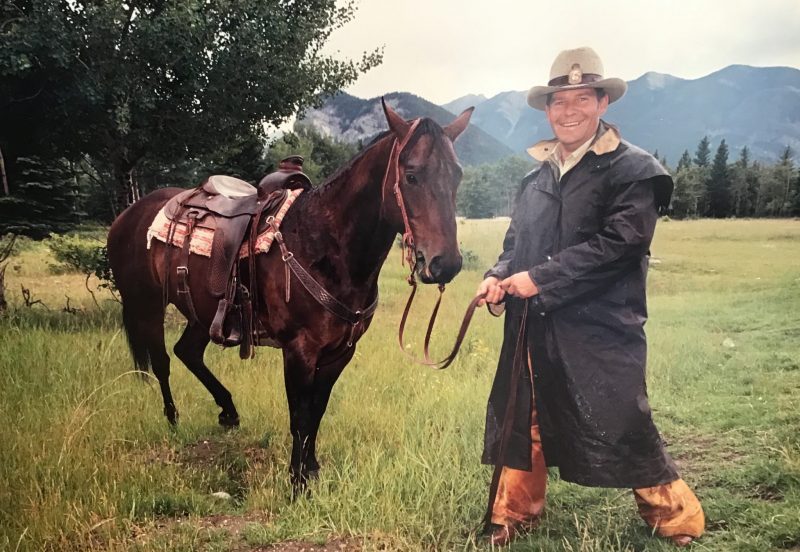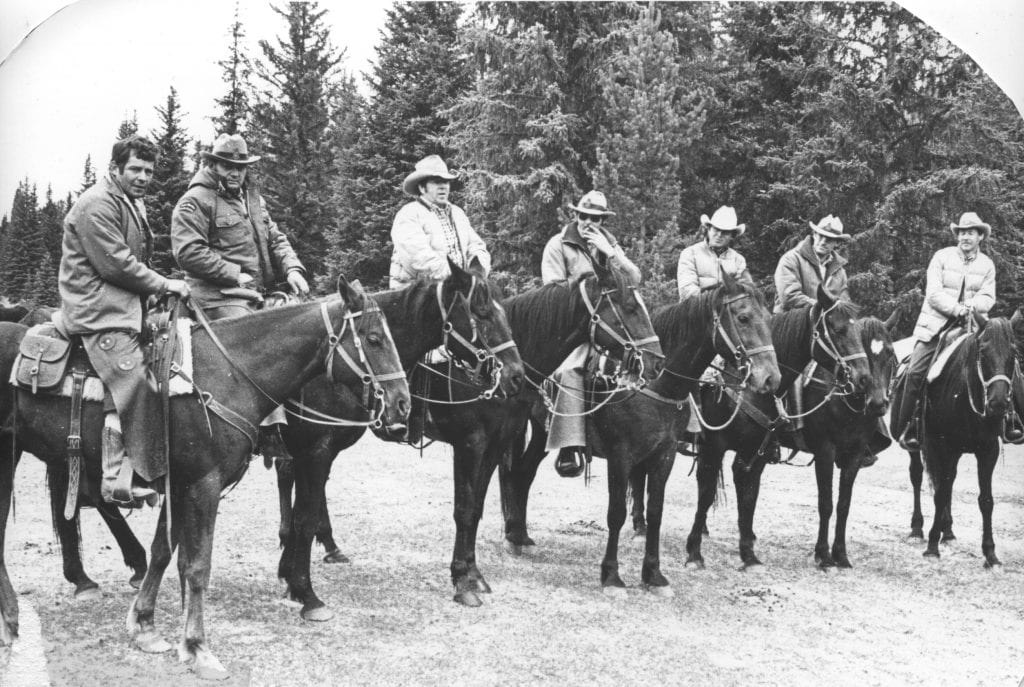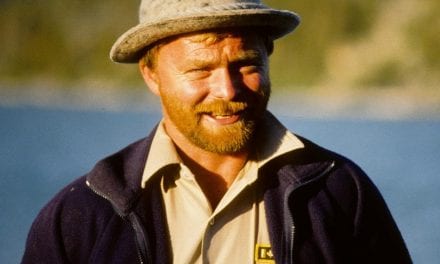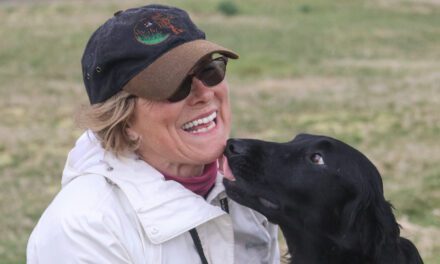Thank you to the Whyte Museum of the Canadian Rockies for granting permission to the Park Warden Service Alumni to post this interview on our website.
This Oral History interview was funded in part by a research grant received in 2019 from the Government of Alberta through the Alberta Historical Resources Foundation.
Park Warden Alumni Society of Alberta
Oral History Phase 9, 2019
In person Interview with Gaby Fortin
Date/time: September 25th 2019@1400
Interviewed by Monique Hunkeler

Place and date of birth? I was born on the Gaspe′ Coast, Quebec on October 3rd 1950
MH: Where did you grow up?
GF: I grew up in a small village on the Gaspe′ coast.
MH: How did you become involved in the Warden Service? Which National Park did you start working in?
GF: In 1970, the Government decided there was going to be National Parks in Quebec, one was in Forillon and the other was in La Maurice. The Park was established in 1970, I finished university in 1973 so it was convenient for us to apply on a job with the Park which is what I did. Forillon National Park was my first park.
MH: What made you want to join the Warden Service? 0132:
GF: The work itself was very attractive because it was varied and there were many options. A lot of outdoors (was) involved and a lot of flexibility in how the work was carried out. It covered a lot of areas that you wouldn’t get to have in other jobs. It was very interesting and very rewarding. The emergency stuff was challenging, with rescues, fires, emergency services etc. We used to run ambulances in Lake Louise, Yoho, Waterton and other places.
MH: What different parks did you work in? How did they compare? Do you have a favourite? 0335:
GF: From Forillon, I went to Waterton on a language exchange to learn how to speak English better. Then I went to Banff. I worked 1973-1979 in Forillon with one year in Waterton. Six years in Banff. Then I went for two years in the district of Montreal which is mainly National Historic Sites and Canals. Didn’t like it very much, it was too urban for me, so then we went to Jasper National Park for 5 years. Then I got into the Mountain Park Director position and then the Director General for all of Western Canada. It was a very challenging and interesting job all over.
O344: It’s hard to make a comparison because they were all nice parks and they all had different challenges. Waterton was probably the nicest. Banff, because it was so challenging, was very interesting too, and Jasper I liked. In other words, I liked probably Waterton then Jasper the best. But that doesn’t mean I don’t like the others. Waterton is one of the nicest places. The closeness to people, it’s so small so you know everyone but at the same time it has all the elements that all the large parks have but in a smaller area.
MH: What were some of your main responsibilities over the years? 0455:
GF: I pretty well covered them all like Resource Management, Law Enforcement, Public Safety but I was always in a management position, Chief Park Warden, Superintendent or Director.
MH: What did you like / dislike about being a Warden? 0523:
GF: I loved the authority that it gave you but also the responsibility that goes with it. Just can’t do anything you want, you had to respect what others were saying and thinking. And again, going back to the variety of the functions but it was also the fact that there was a lot of outdoor work involved which I really liked about the Warden Service.
GF: 0607: Although it was very focused, sometimes it did not take into account other responsibilities that were there. The overall approach of Wardens towards commercial development is an example. I’m not saying it should be wide open but it should take into account that it was part of the job too, and sometimes that was difficult. The other challenges that we had with the sidearm issues and with the roles of the wardens, I could have lived without it. And also again, that’s an example on the sidearm issue. The Warden Service as a whole decided to go against Park Administration, which might be okay but certainly you can tell very easily where it is going to end. I was disappointed in them because to have the whole group of people ganging up against their boss you’re going to lose. That’s a fact of life. It was very difficult to resolve the issue which we could have done the very first day it came up, even though it’s done. I’m not sure if it’s working exactly the way they want but I’m just guessing. You have to remember that I haven’t been involved for 20 years now. The shift for the Wardens was made right after I left and it was a result of the Court of Appeals for Health and Safety so I didn’t have a lot to do with its implementation. All I was involved in was the process before, I wasn’t directly involved in that late decision. That wasn’t the most popular decision but there was a lot of misinformation sent out. Even when you see that in the last book that Kathy Calvert wrote, it probably wasn’t quite accurate – her information. And it’s easy to focus on the one issue and forget about the rest. Even moving forward, the role of the Warden or Resource Conservation people is still great in National Parks and will continue to be so. And if you look at the quality of the work done by Wardens, and by Resource Conservation staff as well, from caribou to all the rest, in a long roundabout way, that’s what I thought could have been different. And sometimes the way that kind of behaviour effected other people and how you deal with the overall. The new organization they gave a greater role to Visitor Services that was not there before. It wasn’t quite there when I left. Personally when I came in, it was centralization and that was another big issue for the Wardens who used to live in the district where they had all the authority and responsibility, having other people interfering in their field of activities. I came in just as this had been done so this was a big issue, especially in the mountain parks.
Like I said before, what I didn’t like much was Montreal because it was too much urban, but because we came from the Gaspe′, we thought we’d be closer to our family. But it’s a lot further away than you think when you’ve got to get ready and take the kids and drive 10 hours. We were lucky we came back to Jasper. I was always involved in a lot of the changes that happened rightly or wrongly. And we did have a lot of changes in the 1980s.
MH: What were some of your more memorable events as a Warden?
GF: 1985 was a big year, the Centennial. There were a lot of activities related to that. For example, we went on horseback in just about every July 1st parade in Alberta. That was kind of fun. The one general thing was more developing of proper methodologies for when you do resource entry work. The Natural Resource work, especially when I was Chief Park Warden in Banff, we did a lot of work at the time. Monitoring programs and all those type of things. I was there when all that happened. I don’t take credit for everything but certainly was involved.
MH: Can you tell me about any rescue/wildlife stories that stick out in your memory? 1233:
GF: It’s hard because I didn’t have to do much myself. Most of my time was in the management of the programs.
MH: How did the Warden Service change over the years? 1240:
GF: First was Centralization in the early 70s when all the Wardens were moved from the districts into Banff or Jasper. Then the question of specialization vs generalists, was another big change and that happened when I was there. It was to make sure that all the people were still involved in all the areas of responsibility of the Wardens. And that wasn’t always well understood or accepted. And also the final achievement of this was the professionalism that was developed and involved in the Mountain Parks especially but also the other Parks. These areas were Public Safety, Resource Management, firefighting, all these were developed in a very professional manner by guys like Cliff White and other Wardens and of course Tim Auger in Public Safety. There were a lot of people in specialized roles in the Warden Service because some of them didn’t want to do any Law Enforcement or were concerned with the amount of Law Enforcement. That was a good thing because even though people were bitter about it there were good things happening in both the Wardens and Resource Conservation.
MH: What about the Warden Service was important to you? 1734:
GF: Horses – I needed to put horses in there somewhere. Preserving resources for the long-term was certainly a key issue. For example, we had been working on the Ski Area Management Guideline for the Parks for over 20 years and still haven’t been able to resolve it. That shows first of all a commitment and then how challenging and complicated things can be. The willingness to discuss openly with other people technically could make a difference and a lot of times we took the position it’s our way or the highway. Maybe there were other ways it could have been done, I don’t know. I don’t want to be a preacher because I’m not there anymore. Everyone does the best that they can with the cards they’ve been dealt.
MH: Are there any legends or stories associated with the Warden Service that you can share? Is there anyone from the Service that stands out in your mind? 1900:
GF: I don’t know. These are tough questions. We’ll leave it for now. We may come back to it.
MH: Is there anything about the Warden Service, as you knew it, that you would like future generations to know? 1940:
GF: Well certainly the dedication and the effort that was made towards the protection of the Park. This is something they should know. A little earlier, I may have been a little critical over certain aspects. It certainly doesn’t reflect the overall Warden Service as such.
MH: What made the Warden Service such a unique organization?
GF: First of all, kind of the family type of approach. Everybody who was a Warden, you could meet any other Warden and they were like family or friends and it didn’t matter where they are from. That’s always there. I’m not sure how that spirit developed but it just happened. You know if you ever get into trouble of some kind and they can help, they will. So I thought it was attractive. Wardens are really well respected so it’s nice to be a part of that community. And they always did kind of fun stuff which is even better. Riding on horseback in the backcountry with a packhorse going in for whatever amount of time, it’s not everybody who has the opportunity to do that. To get the chance to do that and be paid for it is even better. For me, there is more, I don’t want to start telling stories about legends because it is my perception.

Trailing horses to Banff from the Ya Ha Tinda 1985. Gaby Fortin, Larry Gilmar, Johnny Nylund, Bill Browne, Jack Marr, John Taylor, Ian Pengelly. Photo by Bruno Engler.
MH: Do you have any lasting memories as a Warden?
GF: That family system that was there before, I’m not sure if it’s still there and as strong. You look at people like Larry Gilmar, going for coffee every morning, all they talk about is the park.
MH: Any other stories?
GF: Nope.
MH: Do you ever miss being a Warden?
GF: Oh yeah. I miss being able to go out into the backcountry on horseback and using the cabins. Now with the reorganization, we can’t; nor can we bring our own horses. That is something I miss the most personally. But if you like your job and you get to do it, it’s kind of fun and then you miss it of course. Not having anything to do may be more fun, but it isn’t. We had two nice dogs that we used for hunting. We did a lot of that when I retired and that was fun. We are thinking of getting another dog.
MH: Do you have any photos of yourself as a warden that you would like to donate? Artifacts? 2910:
GF: I don’t know where they are. There’s a picture in the Warden office from Bruno Engler of me in the coffee room, when I first moved to Banff. I was 30 years old. You could go and take a picture of it.
MH: What year did you retire? 2500:
GF: 2006
MH: What do you enjoy doing in retirement? 2530:
GF: Bird hunting and we used to go big game hunting with some of the Wardens. I still hike and cycle but as you get older, it’s harder. Your body doesn’t respond all the time. I drove buses and trucks for something different to do but after a while it became like real work, working 10 hours a day, climbing in and out of those big metal boxes, not sure if you’re going to fall or not. So it loses its attraction. I was much busier when I retired than I am right now. I think It’s probably a phase in time and I’ll find something else to do. When you are retired you have a choice whether you’re going to go to work or not. We went back to the Gaspe′ quite a few times. That’s okay too. We have a big trailer but it doesn’t fit in our driveway so whenever we want to go somewhere, I have to go and pick it up from Ron Warner’s and pack everything. It’s easier to stay at home, it’s beautiful. You don’t have to pack; everything is here.
MH: Is there anything I haven’t asked you that you think I should know about the Warden Service? 2950:
GF: I think you’ve asked enough. Feel free to make changes. It’s difficult to answer your questions without taking credit for everything, which I don’t want to do.
MH: Anyone else to interview?
GF: It might be interesting to see what the women have to say. Julie Timmins, Bob Haney and Derek Tilson from Waterton.
(Bob Haney was interviewed In Phase 3. Julie Timmins and Derek Tilson are on the list for future interviews.
MH: Any final comments?
GF: Not for now.

Stoney Creek 1985 Warden Service Reunion
Back row L-R: Joe Halstenson, Jim Raby, Keith Foster, Mac Elder, Andy Anderson, Gord Anderson, Bill Waslenchuck. Jim Quinn, Ruth Quinn, Larry Gilmar, Al Moore, Sid Marty, Bill Vroom (behind Nellie McPhee).
3rd row: Scott Ward, Ina Lee, Doreen Halstenson, Inez Peyto, Nora Peters, Barb Anderson, Margaret Shaddock, Joy Young,
Sharon Anderson, Geraldine Wilkinson, Ruth Quinn, Jane Gilmar, Bert Pittaway, Ron Langevin, Myrna Marty (behind Jim Burles), Jim Burles, Gaby Fortin, Bev Rutherford, Moe Vroom, Nellie McPhee, Alice Hermanrude, Ted Stafford.
2nd Row: Gerry Campbell, Oscar Lee, John Turnbull, Jim VanTassell, Lois VanTassell, Clarence Wilkinson, Elmer Jamieson, Viola Jamieson, Geraldine Kraft, Marlene Langevin, Paul Kutzer, Ed Carleton, Wally McPhee, Ted Anderson.
Front row: Nona Foster, Fred Dixon, Alan Young, Frank Coggins, Frank Lightbound, Ole Hermanrude, Mike Schintz,
Ted Christiansen, Fred Kraft, Marion Kutzer, Dorothy Carleton, Irene Brooks, Colleen Coggins, Glen Brooks.
Photo courtesy of Andy & Barb Anderson.
This interview was conducted by Monique Hunkeler
Monique Hunkeler first started working with Parks Canada in 1989 as Secretary to Banff National Park Finance Manager. She moved into a position as Dispatcher for the Banff Park Warden Service and later worked within Banff National Park and Town of Banff’s IT departments. She is experienced with the interviewing, transcription and archiving process the Park Warden Service Alumni Society.



